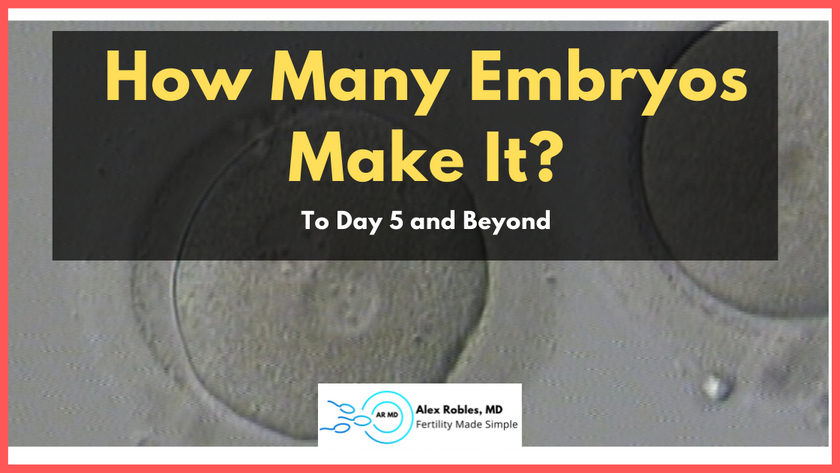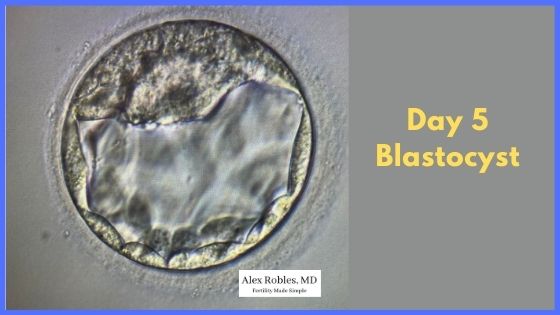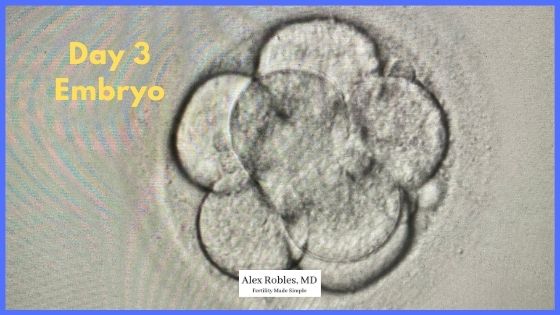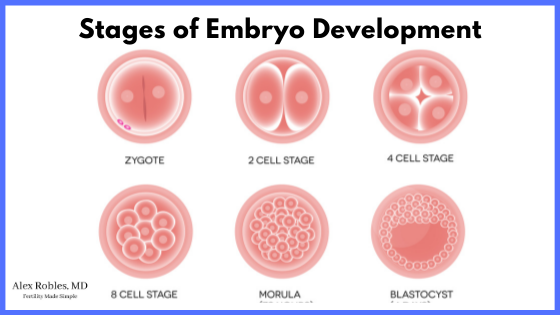One of the unfortunate realities of in vitro fertilization (IVF) is that not all embryos make it to the blastocyst stage.
If you’re currently undergoing IVF treatment, you must be prepared for the possibility that not all of your embryos will make it.
So how many fertilized eggs make it to day 5?
Let’s get started.

How Many Fertilized Eggs Make It To Day 5?
Approximately 40-50% of fertilized eggs (aka embryos) make it to the blastocyst stage. However, this number can vary depending on several factors, including the mother’s age and the quality of the eggs and sperm.
The embryos that don’t make it to Day 5 usually stop dividing on days 3 or 4. Unfortunately, there’s no way to know why an embryo stops developing.
What Exactly Is A Blastocyst?
The blastocyst stage is when the embryo has divided into two distinct groups of cells: inner cell mass (ICM) and trophectoderm. The ICM will eventually become the fetus, while the trophectoderm cells will become part of the placenta.
Typically, an embryo will make it to the blast stage on Days 5, 6, or 7.

Will All Fertilized Eggs Make It To Day 3?
Unfortunately, not every fertilized egg will make it to Day 3, the cleavage stage. Anywhere from 60-80% of all fertilized eggs make it to Day 3, which is when they are about 8-10 cells in size.
Physiologically, a Day 3 embryo is still in the fallopian tube, and it will not arrive in the uterus until Day 5 or 6.
Why Do Some Embryos Stop Developing?
A few risk factors may decrease the probability of an embryo making it to the blast stage.
The first is advanced maternal age. Women over 37 may have a lower chance of their embryos developing to the blastocyst stage. Unfortunately, women’s eggs are more likely to develop genetic or chromosomal abnormalities as they age.
Another factor that can impact embryo development is the quality of the sperm, such as high sperm DNA fragmentation. Unfortunately, there are minimal ways to test for sperm quality and even fewer ways to treat it.
What Is Special About Making It To Day 5?
The main advantage of blastocyst stage embryos is that they increase the chances of implantation and pregnancy.
Embryos that reach the blastocyst stage of development have proven themselves to be of a certain quality by growing and dividing past a certain point in the IVF laboratory.
In addition, a blastocyst embryo is more robust than a cleavage-stage embryo.
In other words, a blast can better withstand embryo freezing, thawing, and a biopsy for genetic testing.
Lastly, having a blastocyst transfer can reduce the risk of multiple births by allowing your doctor to transfer only the single best embryo back to your uterus.

How is Day 5 Different From Day 6 and Day 7?
Generally, a Day 5 blastocyst may have a slightly higher live birth rate than a Day 6 blastocyst. Some studies show no significant differences between Day 5 or Day 6 embryos.
However, a Day 5 or 6 blastocyst has higher success rates than a Day 7 blastocyst.
What Percentage of Eggs Turn Into Embryos?
On average, about 75-80% of retrieved eggs are mature.
Of those mature eggs, approximately 75% will fertilize and turn into an embryo.
With that said, these numbers are just average percentages and can vary from person to person. Either way, the number of eggs you start with can directly impact the number of embryos you’ll have at the end of treatment.
Related post: IVF vs. ICSI (aka conventional insemination vs. intracytoplasmic sperm injection)
What Percentage of Embryos Make It To Birth?
A chromosomally normal embryo has approximately a 70% implantation rate and a 60% chance of a live birth.
Chromosomally abnormal embryos almost never result in an ongoing pregnancy. As such, it is important to consider genetic testing for your embryos if you are undergoing IVF, mainly if you are over 35.
What If No Embryos Make It To Day 5?
If no embryo has made it to the blast stage on Day 5, we will keep the embryos in culture for an additional two days.
If none of your embryos make it to the blastocyst stage by Day 7, then there is likely an issue with egg quality or, in some cases, sperm quality. Unfortunately, IVF success rates depend heavily on the woman’s age.
Perhaps doing another IVF cycle with a different protocol may help, but it’s impossible to know beforehand. Speak with your fertility doctor to learn what options are available to you.

Do Embryo Grades Matter?
Yes, according to the data, embryo grades seem to matter.
Embryo grading is a way for embryologists to classify embryos based on their appearance. If you have two genetically normal blastocyst embryos, we will select the one with the higher grade for embryo transfer.
That said, it is essential to remember that grade is just one factor among many. The grading system is far from perfect, and even embryos that receive a low grade can go on to result in a healthy baby.
Conclusion
The blastocyst stage is an important milestone in embryonic development. The blast stage has a higher chance of resulting in a live birth when compared to an earlier stage of development.
However, it is essential to have realistic expectations. Not every embryo divides, and not every patient will have a blastocyst on Day 5.
Each person is different, and each IVF cycle is unique.
If you have any other questions regarding embryo development or ways to improve your chances of success, please don’t hesitate to schedule a consultation!
Related Posts on The IVF Process:
Make An Appointment With Dr. Robles To Discuss Your Fertility Options Today!

Alex Robles, MD
Dr. Alex Robles is a Spanish-speaking Latino-American Reproductive Endocrinologist and Infertility specialist in New York City, and a board-certified OBGYN. He has a special interest in health, lifestyle, & nutrition. Make an appointment with Dr. Robles to discuss your fertility options today!
References:
- Blake DA, Farquhar CM, Johnson N, Proctor M. Cleavage stage versus blastocyst stage embryo transfer in assisted conception. Cochrane Database Syst Rev. 2007 Oct 17;(4):CD002118. doi: 10.1002/14651858.CD002118.pub3. Update in: Cochrane Database Syst Rev. 2012;7:CD002118. PMID: 17943767.
- Reshef, E. A., Robles, A., Hynes, J. S., Turocy, J. M., & Forman, E. J. (2022). A review of factors influencing implantation of euploid blastocysts after in vitro fertilization. F&S Reviews.
- Glujovsky D, Farquhar C, Quinteiro Retamar AM, Alvarez Sedo CR, Blake D. Cleavage stage versus blastocyst stage embryo transfer in assisted reproductive technology. Cochrane Database Syst Rev. 2016 Jun 30;(6):CD002118. doi: 10.1002/14651858.CD002118.pub5. PMID: 27357126.
- Alvarez Sedó C, Bilinski M, Lorenzi D, Uriondo H, Noblía F, Longobucco V, Lagar EV, Nodar F. Effect of sperm DNA fragmentation on embryo development: clinical and biological aspects. JBRA Assist Reprod. 2017 Dec 1;21(4):343-350. doi: 10.5935/1518-0557.20170061. PMID: 29116706; PMCID: PMC5714603.
